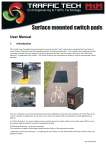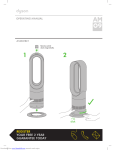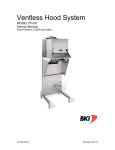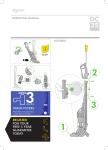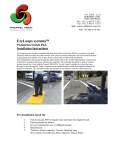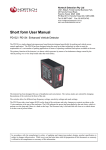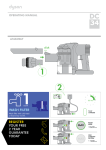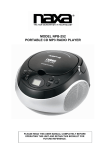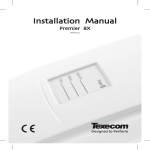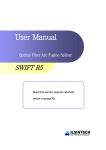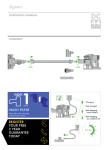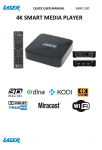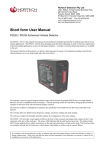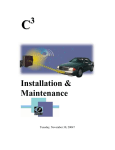Download User Manual - The Civic Group
Transcript
User Manual 1. Introduction EzyLoops Systems, Surface mounted Pedestrian Activated Switch Pads are a pressure activated electronic method of detection that provides both “passive presence detection” and “directional detection” of pedestrians and vehicles. Used with the Nortech PD134TLC Tactile Loop Controller the system has been designed to provide specific “logic” outputs from the patented tactile Switch Pad intended primarily for pedestrian detection. The Switch Pad may also incorporate an inductive loop for vehicle detection. Due to the combination of vehicle and pedestrian detection capabilities, the tactile loop controller and Switch Pad can be used in a number of applications in low speed / low volume (car park) traffic and pedestrian control applications as follows: a) Vehicle detection – by means of the pressure actuation due to the vehicle wheels on the tactile sensor OR by use of the optional built in inductive loop OR a combination of both. b) Pedestrian Detection – by pressure actuation The controller is capable of providing timing functions (delay) of the pedestrian actuation c) Movement Direction detection – in analysing the movements over the Switch Pad to determine direction of movement in both vehicle and pedestrian modes. 2. Hardware Detail 2.1. Switch Pad EzyLoops Systems, Surface mounted Pedestrian Activated Switch Pads are pre-formed and encapsulated in a protective non-slip tactile surface mat, so that they may be laid onto the surface of a pavement as a single unit Pad construction: Heavy-duty, extruded, two-ply vinyl mat, which encapsulates the electronic switches, with a UV resistant, slip resistant, tactile mat surface. The standard sized mat is 800mm wide by 1400mm long. Optional sizes through to 1400mm wide by 2400mm long. Electrical details: Max Operating Voltage: 24 V DC Operating Current: Min 50 micro amps to 20 milli amps Max, Resistive. Feeder cable, Min 3 core x (0.75mm2) multi-strand insulated cable. 2.2. Tactile Loop Controller The PD134TLC Tactile Loop Controller is designed to be shelf or DIN rail mounted with the controls and visual indicators at the front and wiring at the rear of the enclosure. The power, switch pad connections and relay outputs and inputs are all connected to the 11-pin plug, which is mounted at the rear of the enclosure. This connector mates with the DIN Rail mount screw terminal base. Figure 2.1 Tactile Loop Controller Page 2 of 12 2.3. Switch Pad interface The Switch Pad is connected to controller by means of a supplied cable with an interface at the switch pad end. Figure 2.2 Tactile Mat Interface 3. Operating Modes To accommodate the numerous application requirements, this versatile unit may be configured to operate in one of 4 distinct modes. These modes are : 3.1. 1. Tactile Presence mode, with / without delay – (optional Loop) 2. Vehicle Presence mode – Tactile and Loop 3. Loop Direction mode 4. Tactile Direction mode Tactile Presence Mode – (optional Loop) In this mode the controller provides two separate “presence” outputs. One of these is dedicated to the tactile switches in the switch pad that respond to pressure. The second output becomes functional if an optional detection loop coil is embedded in the switch pad. This detection loop coil (vehicle detector) senses the metal content of a vehicle above the switch pad. The tactile output provides a “presence” output while a vehicle wheel or pedestrian is standing on the switch pad. This output may be immediate when the pressure is applied or delayed by switch settings on the controller. This output is constant for the duration of the pressure applied to the switch pad. The delay settings provided are 2 seconds, 4 seconds and 6 seconds. When this delay is selected, the tactile output only occurs after the delay period. Therefore there will be no output when pedestrians or vehicles pass over the sensor and do not remain there for the length delay period. When a delay is selected, there is also a default time extension of 4 seconds. This means once the actuation is removed after the delay period has expired; the output will remain on for a further 4 seconds. If pressure is reapplied again before the 4 second period has expired, the output will remain on constantly. The optional vehicle detector output is immediate when a vehicle is present and is constant for the duration of the vehicle presence. The vehicle detector output is unaffected by any delay settings. The intended application for this mode is without the optional vehicle loop and is for “passive pedestrian detection” at signalised pedestrian crossings. Page 3 of 12 3.2. Vehicle Presence Mode In this mode the switch pad is provided with a detection loop coil that senses the metal content of the vehicle above the switch pad. The loop detector output of the controller provides a “presence” output while a vehicle is present over the loop coil. This output is immediate when the vehicle arrives and remains on for the duration of the vehicle presence. Any timing functions selected to not apply for this output. The second “pedestrian” output operates as described in the “Tactile Presence Mode” above with the important exception that a vehicle presence disables the tactile output. Therefore the tactile output positively identifies a pedestrian presence in the absence of a vehicle over the sensor. The intended application for this mode is for monitoring pedestrian and traffic movements on a traffic ramp or similar area, providing alarms to drivers or pedestrians of traffic/pedestrian movements. It is also ideal for the detection of bicycles that are stopped in a “bike lane” that is directly adjacent to a vehicle lane. In this situation the tactile provides an output in the presence of a bicycle but without the presence of a vehicle. A Bicycle is identified because, with the absence of a vehicle presence to disable the tactile output, it can be assumed that the tactile has been activated by a bicycle. 3.3. Vehicle Directional Mode In this mode the switch pad is provided with an optional detection loop coil that senses the metal content of the vehicle above the switch pad. The loop detector output and the tactile sensors are used to determine a vehicle presence and the direction of the vehicle. In this mode an output is provided immediately on the appropriate direction output of the controller. This output is immediate when the vehicle arrives and remains on for the duration of the vehicle presence. Any timing functions selected to not apply for this output. In this mode any actuation of the switch pad by pedestrian movements are ignored. The intended application for this mode is for monitoring vehicle movements where directional information is required. 3.4. Tactile Direction mode (no loop) In this mode the controller attempts to analyse the direction of the vehicle or person traversing the switch pad and to provide an output based on the direction determined. When the passage of a wheel is sensed, the switch pad immediately activates the appropriate direction output. Such output remains constant while the pressure of the wheel remains on the sensor. The intended application for this mode is for monitoring bicycle or wheel-chair movements where direction determines the action to be taken. Where a wheel presence is not detected the controller assumes the actuation is due to pedestrian movements on the switch pad. In this case the direction may only be determined when the pedestrian moves off the switch pad. In this case a brief output pulse is provided on the appropriate direction output once the sensor is completely de-activated. Note that further direction outputs may only occur once the switch-pad has been completely vacated between events. The delay feature is inoperable in the direction mode regardless of delay switch settings. Page 4 of 12 4. Operating Instructions 4.1. Switch Setting Selections The faceplate switch settings allow the configuration of the operating mode of the controller, the time delay settings for the tactile outputs and the inductive loop settings when the optional detection loop coil is imbedded in the sensor. 4.1.1. Default switch settings All of the 8 switches on the faceplate Mode switch should initially be set to the “OFF” position. This is the situation where all switches are set to the right hand side as indicated in Fig 4.1. 4.1.2. Mode Selection One of the 4 operating modes must be selected according to the application. These modes and their applications are described in Section 3. The mode of output is selected by switches No.7 and 8 on the front of the enclosure and is as follows: SW8 SW7 Off Off On On Off On Off On Tactile Presence Mode (optional loop) Vehicle Presence Mode Vehicle Directional Mode Tactile Directional Mode ON Fig 4.1. Faceplate Details 4.1.3. Delay Selection The Tactile Presence Outputs are normally immediate, but can be delayed by switch settings. Each Delay setting has a default “extend” setting as described in Section 3.1 This delay operates ONLY on the Switch Pad tactile outputs and is inoperative in the DIRECTION Modes. The delay selected by switches No.5 and 6 on the front of the enclosure and is as follows: SW6 SW5 Off Off On On Off On Off On Delay option off, Extend option off. Delay = 2 seconds, Extend = 4 seconds Delay = 4 seconds, Extend = 4 seconds Delay = 6 seconds, Extend = 4 seconds 4.1.4. Vehicle Detector Switch Settings The vehicle detection loop is optionally embedded in the Switch Pad. If a loop is not connected Switches 1 – 4 only should remain off as described in Section 3.2.1. 4.1.5. Sensitivity The sensitivity of the detector allows the detector to be selective as to the change of inductance necessary to produce a detect. There are four sensitivity selections and are set as follows: SW4 SW3 Off On Off On Off Off On On High Medium-High Medium-Low Low Med -Low and Low sensitivity settings will generally ignore bi-cycles, high setting may be prone to ambient electrical noise on some sites. Page 5 of 12 4.1.6. Frequency The frequency switches are the lower two switches, numbered 1 and 2. There are four frequency selections and are set out as follows: SW2 SW1 Off Off High On Off Medium-High Off On Medium-Low On On Low The frequency switches allows the operating frequency of the loop to be shifted higher or lower depending on the switch position. The frequency of the loop is determined by the loop size, and the frequency of the switch simply causes a frequency shift on the loop. Where more than one detector is used the detectors must be set-up to ensure that there is no cross-talk (interference) between the detectors. This can be achieved by ensuring that the loops of the two detectors are spaced sufficiently apart (approximately 2 metres between adjacent edges) and also ensuring that the detectors are set to different frequencies. As a general rule, the detector connected to the inductive loop with the greatest inductance should be set to operate at the lowest frequency. Loop inductance increases as loop size, number of turns in the loop and feeder length increases. 4.1.7. Reset Switch The detector automatically tunes to the inductive loops connected to it when power is applied, whether on initial installation or after any break in the power supply. Should it be necessary to retune the detector, as may be required after the changing of any switch selections, momentary operation of the RESET switch will initiate the automatic tuning cycle. On power up the controller checks all tactiles in the Switch Pad and excludes any faulty lines. The reset switch does not initiate a re-check of the Switch Pad; recycle the power to achieve this. 4.2. Front Panel Indicators 4.2.1. Power Indicator The Power (Red) LED will glow permanently to indicate that the unit is functional. The red LED also serves as an optical interface to the DU100 Diagnostic Unit. 4.2.2. Status Indicator The STATUS (green) LED will normally be off once the unit is functional. The green LED will also glow whenever a vehicle is detected passing over the inductive loop or due to pressure applied on the tactile mat. The green LED will also indicate the vehicle loop tuning and fault conditions as follows: 1. Detector Tuning While the detector is tuning the presence LED (Green) will be on. It will extinguish when the system is tuned. The green LED will flash at a rate of 1 Hz after tuning. This is used to indicate the frequency of the loop to the user. Every flash of the LED is equivalent to 10 kHz. It will stop when the operating frequency is reached. This operation is also performed whenever the reset button is depressed. 2. Loop Sensor Faults If a fault occurs with the loop, the green LED will come on and flash off at the rate of 2Hz indicating the fault. If the fault is self-healing the detector will recommence operation. However the LED will remain on, but will go off for brief intervals in periods of undetect indicating that a fault has occurred. This “fault memory” condition can be restored by removing the power or by depressing the reset button. Page 6 of 12 4.3. Outputs 4.3.1. Relay Outputs The controller provides two normally open relay contacts to indicate presence and direction outputs as follows: 1. Tactile Presence mode – (optional Loop) Relay 1 Relay 2 Loop Presence (optional) Tactile Presence Presence Mode means that any detect on the loop will generate an output on Relay l, whereas a detect on the tactile mat will generate an output on Relay2. The output will persist for the duration of the presence of the vehicle and / or pedestrian (subject to delay settings). With no loop in use there will be no outputs on Relay 1 2. Vehicle Presence mode – Tactile and Loop Relay 1 Relay 2 Loop Presence Tactile Presence Presence Mode means that any detect on the loop will generate an output on Relay l for the duration of the detect, whereas a detect on the tactile mat will generate an output on Relay2 for the duration of that detect (subject to delay settings) Page 7 of 12 3. Loop Direction mode Relay 1 Relay 2 Direction A-B Direction B-A Loop AB Logic mode will generate an output based on the direction of a vehicle over the loop using the tactile mat as the second "loop" to determine the direction. Important to note is that the vehicle will have to be undetected before another output will be generated. 4. Tactile Direction mode Relay 1 Relay 2 Direction A-B Direction B-A Tactile Direction Logic mode is capable of determining the direction of either a pedestrian or a vehicle using only the Tactile Mat itself. The loop state is not taken into account here; a vehicle passing over the loop will have no effect on the relay outputs. Page 8 of 12 5. Installation 5.1. Tactile Controller installation The PD134TLC detector is designed to be shelf or DIN rail mounted with the controls and visual indicators at the front and wiring at the rear of the enclosure. The power, loop and relay outputs are all connected to the single 11-pin plug, which is mounted at the rear of the enclosure. The screw terminal base is used for connections to the unit. Also the unit interfaces to tactile mat via the Tactile Mat Interface, the 301 FT0218, which connects via the 11-pin plug. 32 Figure 5.1 PD134TLC Controller Housing detail. 5.2. Tactile Controller wiring detail 11-Pin connector wiring for the PD134TLC 301FT0041 WIRING HARNESS WIRE COLOUR PIN # FUNCTION Red 1 Power Supply Black 2 Power Supply Grey 3 N/O Relay 2 Contact Violet Yellow 4 5 Common Relay 2 Contact N/O Relay 1 Contact (2 Amp and 240V ac max) Brown 6 Common Relay 1 Contact White/Blue 7 Loop Blue White/Brown/Green 8 9 Loop Tactile Mat Ground Orange/Brown 10 Tactile Mat Power Green 11 Tactile Mat Communication Page 9 of 12 12-24V AC-DC 45-65Hz 0.2A Max (2 Amp and 240V ac max) Twist this pair Connect switch pad interface here, see Fig 5.3 5.3. Switch Pad Interface detail Switch Pad interface cable connection to the PD134TLC Part number 301ND0220 (to be used without loop) Part number 301ND0221 (to be used with loop) Figure 5.2 Switch Pad Interface Connector wiring for the PD134TMI - Part number 301 FT 0218 8core Cat 5 cable White/Brown Brown White/Orange Orange White/Green Green White/Blue Blue PIN # 1 2 3 4 5 6 7 8 FUNCTION Tactile Mat Ground Tactile Mat Power Supply Tactile Mat Ground Tactile Mat Power Supply Tactile Mat Ground Tactile Mat Communication Loop Twist this pair Loop Figure 5.3 Cable to connect to the PD134TLC detector Page 10 of 12 5.4. Switch Pad Installation 5.4.1. Pedestrian Crossing application Pedestrian actuated signal devices are part of many traffic signals and require the user to push a button in order to activate a walk signal indicator and initiate a WALK interval. Use of pushbuttons may also lengthen a WALK interval to provide adequate crossing time. Without a supplemental “passive” pedestrian detection device, there is no guarantee that the signals will activate or lengthen a walk interval when necessary. The Pedestrian Activated Detection Pads are designed to be placed in situations where pedestrian interaction with a pushbutton is known to be periodic or where there are high volumes of disabled pedestrians that may find it difficult to locate and/or reach the button to initiate or lengthen a walk interval. Installation of the surface mounted pedestrian pad is by way of a single part adhesive (Seka Flex 521 UV). Once the location of the pad has been determined, mark-out around the pad with masking tape. A small rebate need to be cut out of the area that the feeder cable exits the underside of the pad, this is to reduce the chances of the lead wire being damaged by being “pinched” if a car drives over the pad. Then cut a chann el 10mm deep and 5mm wide, from the point that the lead wire exits the pad to the nearest PJ Box. Then drill a hole down into the box. Apply the adhesive to the underside of the pad and place it in position, being sure to have the lead wire exit point over the rebate. If the surface that the pad is being install on, is asphalt, then the pad can be order with a “Butyl” adhesive already applied to the underside of the pad. If this is the case, the surface should be primed with a butyl adhesive primer or similar, then simply peel off the backing paper and stick the pad down. Once the pad is installed, place a number of small sand bags on the pad to hole it down while the adhesive cures. This will take approximately 15 min. Seal the lead wire channel and then finish connection in the junction box. Page 11 of 12 5.4.2. Bicycle Detection Application The Bicycle Switch Pad (BSP) is only 5mm thick and constructed of heavy duty non-corrosive materials with a non -slip surface. The switch pad is simply adhered to the surface of an existing bike lane or path approaching a road crossing or intersection. This patented Bicycle Switch Pad (BSP-1200) has been designed to be an alternative to a call button as well as being able to cancel a call if vacated. Each button or rows of buttons on the switch pad can be individually activated so that both presence and direction can be determined. The installation of the Bicycle pad is the same as with the pedestrian pad, described on Page 11. And as with the pedestrian pad, if the surface that the pad is being installed on, is asphalt, then the pad can be ordered with a “Butyl” adhesive already applied to the underside of the pad. If this is the case the surface should be primed with a butyl adhesive primer or similar, then simply peel off the backing paper and stick the pad down. The Civic Group Unit 74, Block 503 Greenogue Business Park, Rathcoole, Co. Dublin Tel: +353 1 4019914 Fax:+353-1-4019140 Email: [email protected] Web: www.civic.ie












